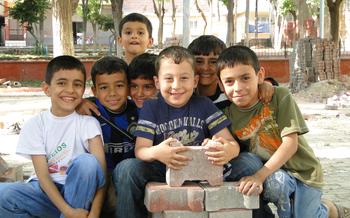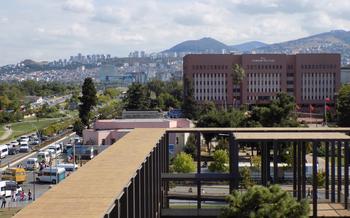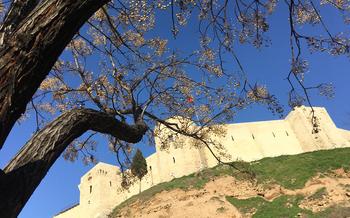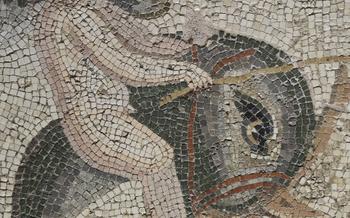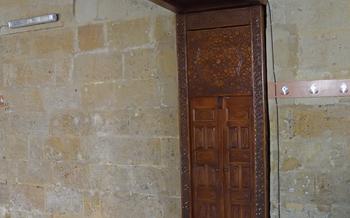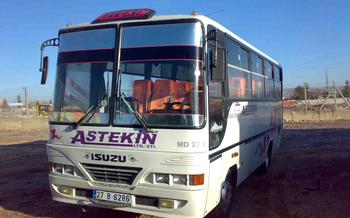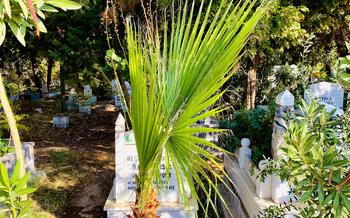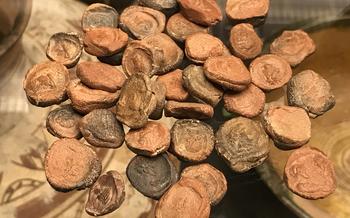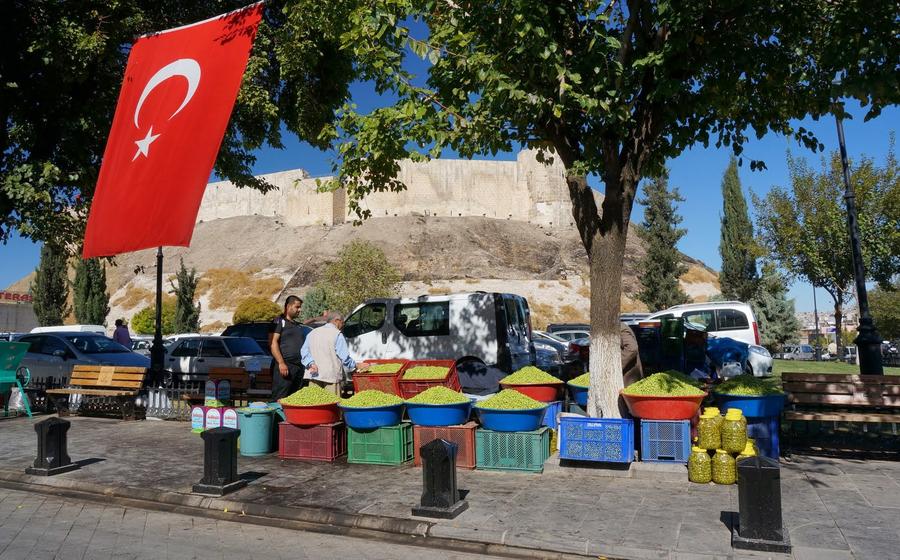
Ali Ihsan Göğüş Museum of Archeology
- About the Ali Ihsan Göğüş Museum of Archeology
- Archeological Treasures
- Statues and Sculptures: Artistic Masterpieces of Ancient Civilizations
- History of Gaziantep
- Interactive Displays
- Guided Tours
- Museum Shop
- Accessibility
- Educational Programs
- Events and Exhibitions
- Local Cuisine:
- Nearby Attractions
- Insider Tip: Unveiling Hidden Gems
About the Ali Ihsan Göğüş Museum of Archeology
The Ali Ihsan Göğüş Museum of Archeology stands as a testament to the rich cultural heritage of Gaziantep, Turkey. Established in 1944, the museum pays homage to the life's work of Ali Ihsan Göğüş, a renowned Turkish archeologist and art historian. Göğüş' unwavering dedication to preserving and showcasing the region's antiquities led to the creation of this remarkable institution, which has since become a treasure trove of archeological wonders.
Architecturally, the museum blends modern design with traditional elements, creating a harmonious space that complements the ancient artifacts within. Situated in the heart of Gaziantep, the museum is easily accessible, inviting visitors to immerse themselves in the captivating journey through history that awaits them.
Archeological Treasures
The Ali Ihsan Göğüş Museum of Archeology houses a remarkable collection of artifacts from various ancient civilizations that once flourished in the region. One of the highlights of the museum is a stunning collection of mosaics, which showcase the artistic prowess and storytelling abilities of ancient artisans. These mosaics depict scenes from mythology, daily life, and historical events, offering a glimpse into the lives and beliefs of past civilizations. Each mosaic is meticulously crafted using small, colored tiles, forming intricate patterns and vivid representations.
Some of the most notable artifacts in the museum include a 4th-century BC statue of the Greek goddess Artemis, a Roman bust of Emperor Hadrian, and a collection of intricately carved Hittite reliefs. These artifacts provide valuable insights into the cultural, religious, and artistic traditions of the ancient world. The museum also displays a range of other artifacts, such as jewelry, pottery, tools, and weapons, which offer further glimpses into the daily lives of ancient peoples. The collection at the Ali Ihsan Göğüş Museum of Archeology is a testament to the rich cultural heritage of Turkey and the region, showcasing the creativity, innovation, and artistry of ancient civilizations.
Statues and Sculptures: Artistic Masterpieces of Ancient Civilizations
The Ali Ihsan Göğüş Museum of Archeology boasts a remarkable collection of statues and sculptures that span various historical periods and civilizations. These remarkable works of art showcase the exceptional craftsmanship and artistic prowess of ancient artisans.
The museum's collection includes a diverse range of statues, from imposing stone sculptures to delicate bronze figurines. Each piece is crafted with intricate details and exhibits unique characteristics that reflect the cultural and artistic influences of the time.
One of the highlights of the collection is a magnificent statue of the Roman emperor Augustus. The statue, carved from white marble, portrays the emperor in a commanding stance, emphasizing his authority and power. The intricate details of his facial features and clothing provide a glimpse into the artistic style of the Roman Empire.
Another notable piece is a bronze sculpture of a dancing satyr. The satyr, a mythological creature associated with wine and revelry, is depicted in a dynamic pose, capturing the essence of movement and energy. The intricate details of the satyr's anatomy and the expressive facial features demonstrate the sculptor's mastery of the human form.
These statues and sculptures not only serve as aesthetic masterpieces but also offer valuable insights into the history, mythology, and cultural beliefs of the ancient civilizations that created them. They provide a tangible connection to the past, allowing visitors to appreciate the artistic achievements of our ancestors and gain a deeper understanding of their world.
History of Gaziantep
Gaziantep, a city nestled in southeastern Turkey, boasts a rich and captivating history that spans several millennia. Its strategic location at the crossroads of ancient trade routes made it a melting pot of diverse cultures and civilizations.
In ancient times, Gaziantep was part of the Hittite Empire, leaving behind impressive ruins and artifacts that testify to its glorious past. The city's name, derived from the Armenian word "Antep," meaning "a high place," reflects its prominent position in the region.
During the Roman period, Gaziantep was transformed into a prosperous city known as "Antiochia ad Taurum," serving as a significant trade center. Its strategic importance attracted various empires, including the Byzantines and Seljuks, who left their mark on the city's architecture and culture.
The Ottoman Empire's arrival in the 16th century brought a period of stability and economic growth. Gaziantep flourished as a center of commerce, with its renowned pistachio trade earning it the nickname "the Pistachio City."
Gaziantep's rich history is deeply intertwined with its architectural heritage. The city is home to numerous historical landmarks and monuments that reflect its diverse past. The majestic Gaziantep Castle, with its imposing walls and towers, stands as a testament to the city's resilience and strategic significance.
Gaziantep's cultural heritage is equally vibrant, with traditional cuisine, handicrafts, and festivals showcasing the city's unique identity. Its world-renowned baklava, a sweet pastry filled with layers of filo dough and chopped nuts, is a culinary delight that attracts visitors from around the globe.
As you explore the streets of Gaziantep, history comes alive, offering a glimpse into the diverse civilizations that have shaped this remarkable city.
Interactive Displays
The Ali Ihsan Göğüş Museum of Archeology takes visitors on a journey through time with its innovative and interactive displays. Utilizing state-of-the-art technology, the museum provides an immersive experience that brings history to life. Virtual reality experiences allow visitors to step back in time and explore ancient civilizations, while multimedia presentations showcase artifacts and historical events in a captivating manner. Interactive touchscreens offer detailed information and insights into the exhibits, making learning fun and engaging. The museum also caters to families and children with interactive games and activities designed to spark curiosity and imagination.
Guided Tours
Enhance your visit to the Ali Ihsan Göğüş Museum of Archeology by taking advantage of the guided tours offered in multiple languages. Led by knowledgeable and experienced guides, these tours provide a deeper understanding of the museum's remarkable collection.
Benefits of Guided Tours:
-
Expert Insights: Guides offer in-depth historical and cultural context, bringing the artifacts to life.
-
Customized Experience: Tours can be tailored to your interests, whether you're fascinated by ancient civilizations, art, or archeology.
-
Interactive Learning: Guides encourage questions and discussions, creating an interactive learning environment.
-
Personalized Recommendations: Guides can suggest additional sites or activities based on your interests.
Booking Information:
-
Availability: Guided tours are available throughout the day, but it's advisable to book in advance to secure your spot.
-
Fees: Guided tours typically come with a small fee, which may vary depending on the group size and duration of the tour.
-
Languages: Tours are offered in several languages, including English, Turkish, Arabic, and German.
Whether you're a history buff, an art enthusiast, or simply curious about the past, a guided tour of the Ali Ihsan Göğüş Museum of Archeology is an enriching and unforgettable experience.
Museum Shop
The Ali Ihsan Göğüş Museum of Archeology houses a well-curated museum shop, offering a diverse range of souvenirs and educational materials to enhance your visit. Whether you seek to commemorate your time at the museum or delve deeper into the world of archeology, the museum shop has something for everyone.
Unique souvenirs, such as replicas of ancient artifacts, decorative items inspired by Anatolian motifs, and handcrafted pottery, make for cherished mementos. Books covering various aspects of archeology, history, and art provide a wealth of knowledge for enthusiasts. Postcards, featuring stunning images of the museum's artifacts, serve as beautiful reminders of your visit.
By making a purchase at the museum shop, you contribute to its conservation efforts, ensuring that future generations can continue to appreciate and learn from its invaluable collection. The friendly and knowledgeable staff is always ready to assist you in finding the perfect item or provide recommendations based on your interests.
So, as you explore the Ali Ihsan Göğüş Museum of Archeology, take some time to visit the museum shop. You might just find that special souvenir or educational resource that will enrich your understanding of Anatolia's rich cultural heritage.
Accessibility
The Ali Ihsan Göğüş Museum of Archeology is committed to providing an inclusive and accessible environment for all visitors. Wheelchair accessibility is ensured throughout the museum, with designated parking areas for visitors with disabilities. Visitors with hearing or visual impairments can request assistance from the museum staff, who are trained to provide support and guidance. The museum also offers inclusive programs and initiatives, such as tactile exhibits and audio guides for visitors with visual impairments. These initiatives aim to create a welcoming and enriching experience for all visitors, regardless of their abilities.
Educational Programs
The Ali Ihsan Göğüş Museum of Archeology is not just a repository of ancient artifacts but also a center for learning and education. It offers a range of educational programs and initiatives to engage visitors of all ages and backgrounds.
-
Workshops and Lectures: The museum regularly hosts workshops and lectures conducted by experts in archeology, history, and related fields. These events provide participants with in-depth knowledge and insights into various aspects of Gaziantep's rich cultural heritage.
-
Educational Programs for Students: The museum collaborates with educational institutions to develop and deliver educational programs tailored for students of different levels. These programs include guided tours, interactive activities, and hands-on experiences, fostering a deeper understanding of archeology and history.
-
Research Opportunities: The museum welcomes researchers and scholars to conduct research using its extensive collection and resources. It provides access to archival materials, databases, and specialized libraries, facilitating academic pursuits and contributing to the advancement of knowledge.
-
Public Awareness Programs: The museum organizes outreach programs and initiatives to raise public awareness about the importance of archeology and cultural heritage preservation. These programs include exhibitions, seminars, and community events that engage a wider audience and promote appreciation for Gaziantep's rich past.
Events and Exhibitions
The Ali Ihsan Göğüş Museum of Archeology hosts a variety of temporary exhibitions and special events throughout the year, providing visitors with an opportunity to explore specific themes and artifacts in greater depth. These exhibitions showcase unique pieces from the museum's collection or feature collaborations with other institutions, offering a fresh perspective on the region's cultural heritage.
Thematic exhibitions focus on particular periods, cultures, or artistic styles, allowing visitors to delve deeper into the history and significance of the artifacts. These exhibitions often feature interactive displays, multimedia presentations, and guided tours, providing an immersive and engaging experience for visitors of all ages.
Cultural performances, workshops, and lectures are also organized in conjunction with these events, creating a vibrant and dynamic atmosphere within the museum. These events provide an opportunity to learn from experts, engage with the local community, and gain a deeper understanding of the rich cultural traditions of Gaziantep and the surrounding region.
Advance booking for special exhibitions and events is recommended, as they tend to attract a large number of visitors. Ticket information and schedules can be found on the museum's website or by contacting the museum directly.
Local Cuisine:
Gaziantep, the city where the Ali Ihsan Göğüş Museum of Archeology resides, is renowned not only for its historical riches but also for its delectable cuisine. Visitors to the city have the chance to indulge in a culinary adventure as they explore the diverse flavors and specialties of Gaziantep.
The city holds a special place in Turkish cuisine, being famous for its mouthwatering dishes that reflect the region's rich cultural heritage. Among the must-try dishes for a truly authentic experience is the "lahmacun," a crispy flatbread topped with minced meat, vegetables, and spices. Another local delicacy is "beyran," a hearty lamb soup served with rice and garlic.
Gaziantep is also famous for its sweets, particularly the legendary baklava. This flaky pastry filled with chopped nuts and drenched in syrup is a symbol of the city and a favorite among locals and visitors alike. Other sweet treats to savor include "katmer," a crispy pastry filled with cheese or nuts, and "künefe," a shredded pastry topped with melted cheese and syrup.
To fully immerse in the local culinary scene, visitors can embark on a food tour, where they can sample various dishes at traditional restaurants and learn about the unique culinary history of Gaziantep. Exploring the city's vibrant markets is another excellent way to discover the local ingredients and flavors that make Gaziantep's cuisine so special.
Nearby Attractions
Gaziantep is a treasure trove of historical sites and attractions that complement the Ali Ihsan Göğüş Museum of Archeology. Explore the iconic Gaziantep Castle, a formidable structure that has stood the test of time, offering panoramic city views. Immerse yourself in the vibrant Zeugma Mosaic Museum, home to an exceptional collection of ancient mosaics that depict scenes from mythology and daily life.
Craft an itinerary that allows you to delve deeper into Gaziantep's rich heritage. Visit the Tarihi Sanko Park, a sprawling complex that houses a traditional Turkish bazaar, a museum, and a stunning botanical garden. Step into the Gaziantep War Museum to learn about the city's resilience during the Turkish War of Independence.
For a unique glimpse into local culture, stroll through the Old City, where narrow streets are lined with historic buildings, shops, and charming cafes. Indulge in the flavors of Gaziantep's renowned cuisine at one of the many traditional restaurants, savoring the aromatic kebabs, crispy lahmacun, and delectable sweets that have made the city a culinary paradise.
Insider Tip: Unveiling Hidden Gems
As you explore the Ali Ihsan Göğüş Museum of Archeology, keep an eye out for lesser-known treasures that may not be immediately apparent. In a secluded corner of the museum, you'll find a captivating collection of ancient jewelry, adorned with intricate designs and precious stones. These exquisite artifacts offer a glimpse into the artistry and craftsmanship of past civilizations.
For a unique perspective, head to the museum's rooftop terrace. From this vantage point, you'll be treated to panoramic views of Gaziantep, with its historic landmarks and bustling streets stretching out before you. Capture the essence of the city from this elevated oasis, away from the crowds.
Photography enthusiasts can unleash their creativity by seeking out hidden corners and unique angles within the museum. Experiment with different lighting conditions to capture the beauty of the artifacts in new and captivating ways. Remember to respect the museum's guidelines and avoid using flash photography to preserve the integrity of the exhibits.
